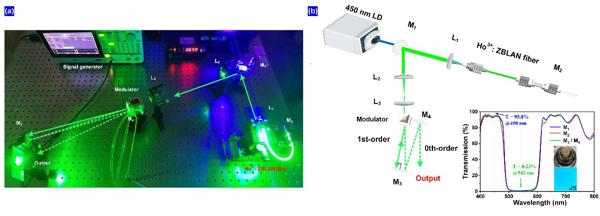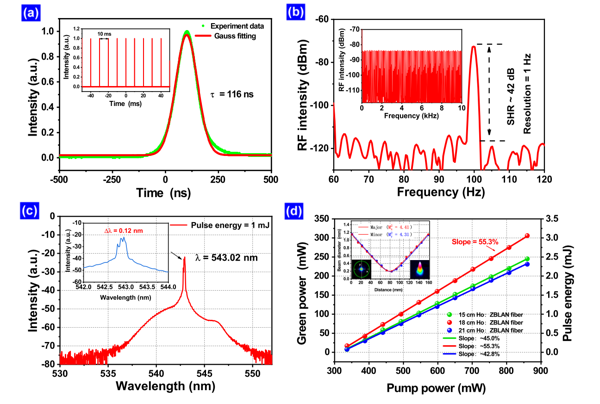The high-energy pulsed laser with green light band (500-560nm) has great application value in scientific research fields such as earth-moon ranging, underwater detection, biomedicine, industrial processing and so on. At the same time, using green pulsed laser as the fundamental frequency light is the most effective and widespread method to generate ultraviolet and deep ultraviolet laser. At present, the mainstream technology to generate high-energy pulsed green laser is still nonlinear frequency conversion (such as frequency doubling/summing) of near-infrared solid or fiber lasers. Due to its large size and complex maintenance, it is difficult to meet the requirements of many applications requiring miniaturized laser, such as airborne, shipborne, earth-moon and underwater detection. Researchers have been seeking a solution for pulsed green laser with high efficiency, small size and free maintenance.
Blue LD pumped rare earth doped fluoride fiber (such as Pr3+, Ho3+, Er3+) under frequency conversion fiber laser is considered to be an effective method to directly generate visible laser. At present, the technology has reached the watt level in continuous wave high power green laser, proving that the direct generation of high energy green light pulses in optical fibers has great development potential to fill the gap in this field of research.
Compared with the traditional Q-switching and mode-locking technologies that directly generate ultrafast pulses of green light, the acousto-optic cavity dumping technique has the advantages of high efficiency, low cavity loss, large pulse energy and high stability, which is suitable for the future application requirements of miniaturized, large energy and high stability visible light pulse laser. In this work, for the first time, green (543nm) pulses of 100Hz and pulse energy of 3.17mJ are directly generated in rare earth fluorine-doped fiber by using acousto-optic cavity dumping technique, which is also the largest green pulse directly generated in rare earth fluorine-doped fiber. That's three orders of magnitude more than previous similar efforts. The relevant research results were published in Photonics Research, Volume 11, No. 3, 2023 (Tianran Li, Ziyu Wang, Jinhai Zou, Jinfen Hong, Qiujun Ruan, Hang Wang, Zhipeng Dong, Zhengqian Luo. Direct generation of 3.17 mJ green pulses in a cavity-dumped Ho3+-doped fiber laser at 543 nm[J]. Photonics Research, 2023, 11(3): 413).
We demonstrate for the first time the generation of millijoules of green light pulses directly from a fiber laser. As shown in Figure 1, the green fiber laser is simply composed of Ho3+: ZBLAN fiber as the gain medium, a series of mirrors with high reflectivity at the green light, a 450 nm diode laser as the pump source and cavity dumping module, and the repetition rate of the output of the green pulse laser is controlled by the signal generator.

Fig. 1. (a) Photograph of green cavity-dumped Ho3+-doped fiber laser. (b) Schematic of green cavity-dumped Ho3+-doped fiber laser. (c) Optical transmission spectra of the visible reflection mirror (M1) at 30° deflection, fiber pigtail mirror (M2), and visible-reflection mirrors (M3, M4), respectively
The experimental results are shown in Figure 2 (a-d). Stable high-energy pulse output is successfully achieved in the green wavelength. The central wavelength is 543.02nm, and the 3-dB line width can be narrowed to 0.12nm. At the repetition rate of 100 Hz, the pulse train is produced stably, corresponding to the pulse energy up to 3.17 mJ, and its spectral signal-to-noise ratio is relatively good. In addition, we optimized the length of Ho3+: ZBLAN fiber by using gain fibers with lengths of 16, 18 and 21 cm. The green output skew efficiency was 45.0%, 55.4% and 42.8%, respectively, and the highest average power of the green pulse was 317 mW.

Fig. 2. (a) Single pulse. (b) RF output spectra at 100 Hz. (c) Output optical spectrum. (d) the average output power as a function of the pump power envelope with gain fiber at different lengths.
It is also the first time that the cavity dumping technique has been applied to rare earth ion doped visible fiber laser. This work provides a new scheme of compact high energy visible fiber lasers for applications in underwater communications, laser display and laser ranging.


